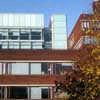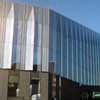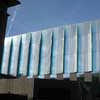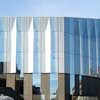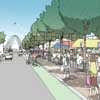Manchester Metropolitan University Hulme, Campus Building Project News, Images
MMU Campus Hulme Manchester : Metropolitan University
Education Development in northwest England
28 Oct 2011
Manchester Metropolitan University
Manchester Metropolitan University building
Photographs © Adrian Welch, 28 October 2011
2 Jul 2009
Manchester Metropolitan University Hulme
John McAslan & Partners unveils design for a new £120M sustainable super-campus
Manchester City Council has approved the masterplan for a £120 million sustainable super-campus for Manchester Metropolitan University (MMU) in Hulme, designed by UKbased architecture practice John McAslan & Partners. A report was submitted to the City Council’s Executive on June 24 to consider the University’s proposals. There will now be a three-month period of public consultation to refine and develop a detailed proposal with the local community before a more formal planning application is made.
The new Birley Fields Campus proposal represents a significant and exciting chapter in the regeneration of Hulme, which was the site of the biggest slum clearance in Europe during the 1960s. The MMU proposal would breathe new life into a 12 hectare site that has been earmarked for development since the 1990s. Birley Fields Campus would create around 340 jobs, boost local shops and services by adding £29million additional annual value to the economies of Hulme and neighbouring Moss Side, and open new paths to higher education for local people.
Bordered by Stretford Road, Royce Road and Princess Road, the integrated ‘community campus’ would house the university’s teacher training and health faculties, educating up to 6,000 professionals for the region’s schools, hospitals, health and social services.
The objective is to establish an environmentally sustainable campus and a test bed for research and evaluation of new models of sustainability within an urban environment. Its significant size allows for large areas of greening and landscaping and, at its heart, an extensive green space linked to surrounding areas of trees and grassland. An open square area would be entirely accessible to the community and buildings will be designed to incorporate the latest environmental technologies to minimise carbon, water and waste and maximise ecology, and supported by a sustainable travel plan.
Aidan Potter, Director at John McAslan & Partners said, “The MMU masterplan complements the city’s strategies for regeneration, public services and sustainable development. The planned £120 million investment is a huge statement of confidence in Hulme – especially in a period of economic recession – and will create worldclass higher education facilities linked and embedded in the local community.
Planning a new integrated campus has also facilitated a groundbreaking approach to environmental sustainability. We anticipate that the campus would be the greenest in the UK. Currently urban campus developments are often restricted by existing services and planning constraints, however by creating a mixed-use estate with integrated activities we can reduce energy consumption, minimise waste, maximise passive natural resources, harvest and recycle rainwater and build in flexibility. The project will also enable us to develop and test cutting-edge solutions for the future.”
MMU Vice-Chancellor Professor John Brooks said, “A brand new campus is not only good news for students and staff but puts the university into the heart of the community it serves creating jobs and opportunity and helping to address crucial agendas for the city on health and education.
The University plans to transform Birley Fields into a lively place of education, with a new public square and shared community facilities on the most sustainable campus in the UK.”
Sir Richard Leese, Leader of Manchester City Council, said, “MMU’s proposal has the potential to herald a new chapter in the regeneration of Hulme. As well as the jobs it directly creates there will be significant spin-off benefits for businesses as students and staff spend money in the area. Crucially, it will also open up new higher education opportunities for local people.”
The £120 million scheme is part of a £400 million investment in MMU campuses across Manchester and Cheshire.
Manchester Metropolitan University Campus Hulme images / information received 020709
John McAslan + Partners
John McAslan + Partners is a leading architectural and design practice, based in London, Manchester and Edinburgh, with a large portfolio of award-winning work in Britain and overseas. The practice has an outstanding track-record in transformational schemes involving culturally and historically significant buildings, including: the Grade I listed Modernist masterpiece, the De La Warr Pavilion at Bexhill on the South coast of England; the renowned Roundhouse arts venue in Camden, London; and the Grade II* listed Peter Jones department store in Sloane Square, London.
The practice is currently working on the £450M development of the Grade I listed King’s Cross station in the heart of London, a project that forms the centrepiece of what will be the most significant piece of urban regeneration in Europe, in addition to the remodelling and transformation of the historic centre of the Stanislavsky family in Moscow for new uses, as well as completing a prominent mixed-use and residential building. The practice has also just recently completed the British Embassy building in Algiers.
In many of its projects, John McAslan + Partners – using up to 10% of its pretax profits – has set up linked pro bono schemes to involve local young people. A separate trust fund has funded a variety of additional schemes in Britain and abroad, including the McAslan/ICE Bursary scheme, administered by the RIBA, to involve young architects and engineers in smallscale design projects. The practice is also working on a number of pro bono projects in partnership with the Clinton Global Initiative, including: the School of Genocide Studies in Kigali, Rwanda, as part of the world-renowned Kigali Memorial Centre; four community schools in Malawi, climate initiatives in Gujurat, India; and a number of community, cultural and education projects in Haiti.
John McAslan + Partners’ work has been published extensively throughout the world, and has won more than 50 international awards.
History of regeneration in Hulme
Hulme’s urban development begun with the Industrial Revolution when it became an industrial suburb located south of the city of Manchester. Initially it housed the people that worked in the industrial quarter of Castlefield, but then the industries themselves started locating to Hulme itself. There was a rapid pace of growth: the population in Hulme expanded 50-fold in the first half of the 19th century. Jobs were created quickly and houses needed to be built fast in limited space.
The quality of the houses was poor and the living conditions were extremely low, with sanitation nonexistent and rampant spread of disease. By 1844, the situation had grown so serious that Manchester Borough Council had to pass a law banning further building. However, the thousands of “slum” homes that were already built continued to be lived in, and many were still in use into the first half of the 20th century.
In the 1930s there was already talk about the redevelopment of Hulme but it was not until after the Second World War in the 1960s that the slums were demolished in the biggest slum clearance programme in Europe. The community was broken up and relocated into estates across the city. Stretford Road, once the most distinctive shopping area outside the city centre, was closed. New system-built housing estates were built and a new and (at the time) innovative design for deck access and tower living was attempted. This consisted of curved rows of flats, known as ‘the crescents’.
This followed design principles fashionable at the time that attempted to segregate the pedestrian from the vehicular traffic. People living in these new flats were re-housed from decaying Victorian slums. High-density housing was balanced within areas of landscaped open space, with the pedestrian having priority on the ground over cars. At the time, the crescents won several design awards, and introduced technologies such as hot air heating systems. They were also popular because they were some of the first council homes in Manchester to have central heating.
Design flaws and unreliable ‘system build’ construction methods, as well as the 1970s Oil Crisis meant that heating the poorly insulated homes became too expensive for their low income residents, and the crescents soon became notorious for being cold and damp. Like many other national examples of deck access housing the long decks were notoriously difficult to police and crime was significant. Within a decade the Crescents were declared ‘unfit for purpose’.
In the early 1980s, the authority pledged itself to a partnership with tenants in planning improvements to its estates. Towards the end of the decade, the Hulme Study was established as a joint venture between local and central government and the community. In principle, the area was to be socially, economically and environmentally redeveloped, the needs of existing tenants addressed and mixed funding sought from public and private sources.
The Hulme City Challenge programme, which ran from 1991 to 1997, was at the time one of the most ambitious regeneration programmes undertaken in Britain. Experts from around the world have visited Hulme to learn from its pioneering progress. But the £35 million spent over that period was eclipsed by the estimated £400 million, from both private and public sources, which was invested in Hulme and neighbouring Moss Side between 1997 and 2002.
While Hulme is now a more desirable place to be, Manchester City Council recognised that its renaissance should continue beyond the end of established funding programmes. The arrival of the Birley Fields campus will give the area fresh momentum, bringing jobs and a host of other potential benefits.
Manchester Metropolitan University Hulme images / information from John McAslan & Partners
Location: Hulme, Manchester, Northwest England, UK
Manchester Buildings
Contemporary Manchester Architecture
Manchester Architecture Walking Tours
Key Northwest English Project by John McAslan & Partners
Liverpool ONE building
Comments / photos for the Manchester Metropolitan University Campus Hulme Architecture page welcome
Website: https://www.mmu.ac.uk/birley/

